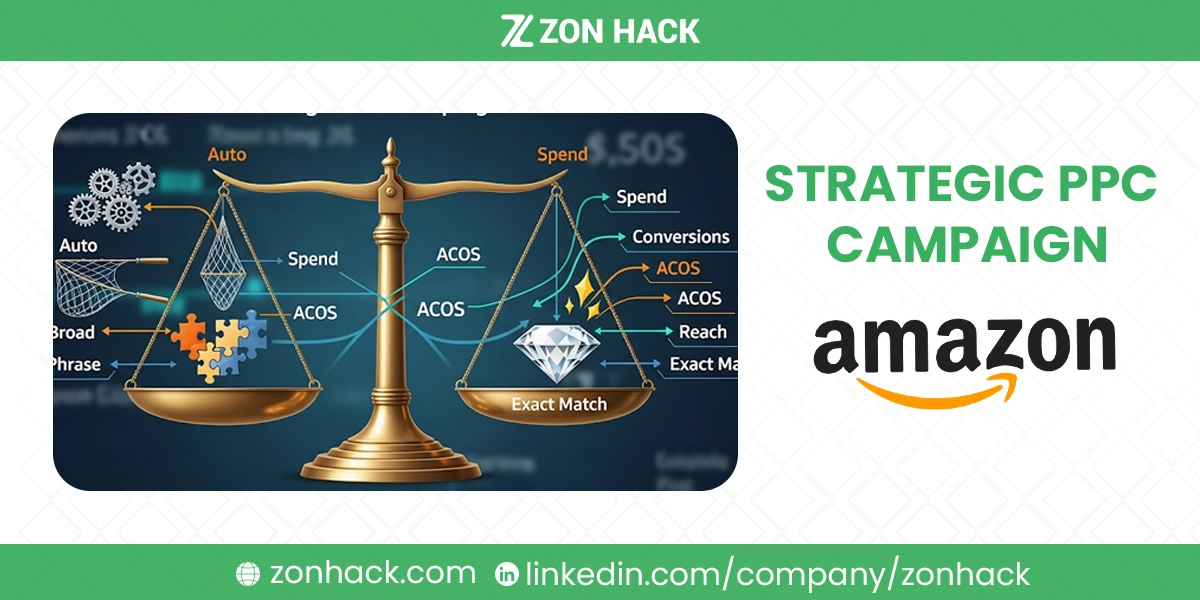Let’s be honest, getting into Amazon’s advertising can feel a bit like trying to solve a Rubik’s Cube blindfolded. So many options, so many settings! But fear not, fellow sellers and marketing enthusiasts, because today we’re going to demystify one of the most crucial aspects of Amazon PPC: balancing your Auto, Broad, Phrase, and Exact Match campaigns. Think of it as building a superstar team where each player has a unique, vital role. Get ready to turn those ad dollars into pure gold (or at least, highly profitable sales!).
I’ve been in the trenches, just like many of you, trying to figure out the best way to make those ad campaigns sing. It’s not just about spending money; it’s about spending it smart. And that, my friends, is where understanding the different match types comes in. Each one is a tool, and like any good craftsman, you need to know which tool to use for the job. We’re talking about making your ads work for you, not just cost you.
Automatic Campaigns (Auto)
Alright, let’s kick things off with the ultimate “set it and forget it” (initially, at least!) campaign type: Automatic.
These campaigns are your loyal assistants, diligently working behind the scenes to help you discover new opportunities. Amazon’s smart algorithm takes your product listing and tries to match it with what customers are searching for. It’s like having a super-smart detective on your team, sniffing out all sorts of relevant search terms you might never have even considered.
Purpose: Keyword Discovery, Initial Product Visibility, and Gathering Data
The main goal here is to let Amazon do some of the heavy lifting. You throw your product into the ring, and Amazon finds the folks who are looking for it. It’s fantastic for getting your product seen right away, especially if it’s new. Plus, it’s a goldmine for data. We’re talking about real customer search terms that are leading to your product. This data is pure magic, trust me.
Strengths
Setting up an Auto campaign is truly a breeze. You don’t need to spend hours brainstorming keywords before you even begin. Just tell Amazon what you’re selling, and it gets to work. This makes it perfect for quickly getting your product out there, especially during peak shopping times or when you’re launching something fresh. The biggest strength, however, is its uncanny ability to unearth those unexpected, long-tail search terms. These are often less competitive and can bring in highly qualified traffic.
- Easy Setup: No complex keyword lists needed right off the bat. It’s almost plug-and-play.
- Keyword Discovery: This is where the real fun begins. You’ll find terms you’d never have guessed people were using.
- Broad Reach: Your product gets seen by a lot of eyeballs quickly. Great for getting that initial traction.
Weaknesses
Now, every superhero has their kryptonite, and Auto campaigns are no exception. Because Amazon is doing the matching, you don’t have as much fine-grained control. This can sometimes lead to your ads showing up for searches that aren’t perfectly relevant, which means wasted clicks and a higher ACoS (Advertising Cost of Sale). It’s like throwing a wide net; you catch a lot of fish, but some might be duds. You also can’t tell Amazon, “Hey, focus more on this specific keyword in my auto campaign.” It’s a bit of a black box in that regard.
- Less Control: You’re trusting Amazon’s algorithm, which is great but not always perfect for your specific goals.
- Limited Optimization: You can’t manually tweak individual keywords within an auto campaign for better performance.
Balancing Strategy
This is where you become the maestro of your Amazon ad orchestra. Auto campaigns are best used as a discovery tool. Think of them as your scouting team.
- Start with Auto: Always, always begin here. It’s your testing ground, your data collection hub. Let it run for a while to gather a significant amount of data.
- Regularly Review Search Term Reports: This is non-negotiable! Dive deep into these reports. They tell you exactly what customers typed to find your product. Look for the gems – the search terms that are converting well with a low ACoS. Also, look for the duds – the terms that are eating your budget without bringing in sales.
- Harvest and Nurture: This is the magic step.
- Positive Keywords: When you find those high-performing search terms in your auto report, harvest them! Take those golden nuggets and add them as keywords to your manual campaigns (Broad, Phrase, or Exact). We’ll talk more about those next.
- Negative Keywords: This is just as important. For those irrelevant search terms that are costing you money, add them as negative keywords to your auto campaign. This tells Amazon, “Hey, never show my ad for this search again.” It’s how you refine your auto targeting over time, making it smarter and more efficient.
- Lower Bids (Once Matured): As your manual campaigns start humming along with those harvested keywords, you can gently lower the bids on your auto campaigns. They’ll continue to discover new long-tail terms at a lower cost, acting as a continuous source of new ideas. Some sellers even pause them once their manual campaigns are fully optimized, but I prefer keeping them on a low simmer for ongoing discovery.
Broad Match Campaigns
Alright, we’ve moved from the automated scout to the “wide net” fisherman! Broad match campaigns are all about casting a wider net than exact, but with a bit more intention than auto.
These campaigns are fantastic for expanding your reach and finding new variations of your core keywords. Think synonyms, misspellings, and related phrases. It’s like telling Amazon, “Show my ad to anyone who’s kind of looking for what I sell.”
Purpose: To Cast a Wide Net and Capture a Broader Range of Related Search Terms
Broad match is your go-to for discovery beyond what auto can find. It allows for a bit more freedom in how your ads appear, giving you more impressions and clicks, and potentially uncovering unexpected customer search behaviors. It’s about finding those adjacent opportunities.
Strengths
The beauty of broad match is its ability to find terms you might not have explicitly targeted. It’s like keyword discovery 2.0. You get a lot of impressions, which means a lot of chances for clicks. Plus, it’s quite flexible – if someone types something slightly different but still relevant, your ad can still show up.
- Discovery: Excellent for unearthing new keyword variations and related terms you hadn’t considered.
- High Impressions: You’ll see your ad appear for a lot of different searches, increasing visibility.
- Flexibility: It’s more forgiving if a customer’s search isn’t an exact match.
Weaknesses
The flip side of that broad reach is, well, less relevance. You might get clicks from searches that aren’t perfectly aligned with your product, leading to a higher ACoS if you’re not careful. It requires constant attention, almost like a toddler needing supervision. Without proper management, broad match can become a budget black hole.
- Lower Relevancy: More chances for irrelevant clicks that don’t convert.
- Less Control: While better than auto, it still has less precision than phrase or exact match.
Balancing Strategy
Think of broad match as your testing ground for new keyword ideas, especially after you’ve pulled some gems from your auto campaigns.
- Initial Discovery (after Auto): Once your auto campaigns have done their initial job, broad match is a great place to start testing those potential new keywords.
- Use Broad Match Modifiers (BMM): Here’s a pro tip! For Sponsored Brands campaigns, you can use something called Broad Match Modifiers. Adding a “+” sign before each word in your broad match keyword (e.g., “+red +shoes”) tells Amazon that each of those words must be present in the customer’s search query. This gives you way more control than a pure broad match, helping to keep things more relevant. It’s like having a little leash on your broad terms.
- Aggressive Negative Keyword Management: This is absolutely vital for broad match campaigns. You must regularly check your search term reports. Identify anything irrelevant that triggered your ad and immediately add it as a negative keyword (either exact or phrase). This is how you sculpt your broad campaigns into efficient machines.
- Lower Bids: Since broad match is less targeted, I always set lower bids for these keywords compared to phrase and exact match. It’s a risk-reward balance.
- Transition to More Specific Match Types: As you identify specific search terms within your broad campaigns that are performing well, don’t be shy! Move those high-fliers to phrase or exact match campaigns. This is how you refine your targeting and increase profitability.
Phrase Match Campaigns
Now we’re getting a little more specific, but still keeping a good spread! Phrase match is like the reliable middle child of match types.
It’s designed to target searches that contain your exact keyword phrase, in the exact order you specify, but it allows for other words to appear before or after that phrase. It’s a sweet spot, offering a fantastic balance between reach and relevance.
Purpose: To Target Searches That Contain Your Exact Keyword Phrase in the Specified Order
Imagine you’re selling “wireless earbuds.” With phrase match, your ad could show for “best wireless earbuds for running,” “cheap wireless earbuds,” or even “wireless earbuds review.” The core phrase “wireless earbuds” stays together, maintaining relevance, but it allows for flexibility around it.
Strengths
Phrase match is a great step up in terms of relevancy from broad match. You’re getting more targeted clicks, which usually means a better chance of conversion. It also has a moderate reach, capturing a good number of searches without being too restrictive. Plus, it can help you discover longer, more specific customer phrases that include your core term.
- Improved Relevancy: Your ads are showing for more specific, related searches.
- Moderate Reach: You’re still getting good visibility, just a more focused kind.
- Keyword Expansion: Great for finding those longer, more specific phrases that convert well.
Weaknesses
While better for discovery than exact, phrase match isn’t going to unearth completely new keyword ideas like auto or broad might. It’s more about refining and expanding on existing ideas. And yes, you’ll still need to keep an eye on those negative keywords because sometimes, despite your best efforts, irrelevant searches can slip through.
- Less Discovery: Not ideal for brand-new keyword discovery.
- Still Requires Negatives: You’ll need to keep weeding out those irrelevant search terms.
Balancing Strategy
I think of phrase match as the sweet spot for many of my campaigns. It’s where a lot of the magic happens in terms of finding profitable mid-tail keywords.
- Harvest from Auto/Broad: This is where you’ll often populate your phrase match campaigns. Those promising search terms you found in your auto and broad reports? Many of them will be perfect candidates for phrase match.
- Mid-Tier Bids: My bids for phrase match keywords are usually higher than my broad match bids but a bit lower than my exact match bids. It reflects the balance of relevancy and reach.
- Refine with Negatives: Just like with broad match, continuous negative keyword management is key. Keep those search term reports open and clean out the clutter to ensure your spend is efficient.
- Identify Exact Matches: As your phrase match keywords perform, you’ll start noticing specific phrases that consistently bring in high conversions. These are your next candidates for exact match campaigns. It’s a natural progression, a beautiful dance between match types!
Exact Match Campaigns
Now, for the sharpshooters of the Amazon PPC world: Exact Match campaigns. These are your precision instruments, designed to hit the bullseye every single time.
Exact match keywords target searches that are precisely your keyword, or very close variations like plurals or slight misspellings. This is where you focus your budget on the absolute highest-intent searches.
Purpose: To Target Searches That Precisely Match Your Keyword or Close Variations
If your exact match keyword is “dog leash,” your ad will primarily show for “dog leash.” It won’t show for “dog harness” or “cat leash.” It’s about maximum relevance and making sure your ad is seen by someone who knows exactly what they want.
Strengths
This is where you see the highest return on your ad spend. Why? Because you’re targeting people who are virtually screaming, “I want that product!” This leads to fantastic conversion rates and, ideally, the lowest ACoS. You also have unparalleled control over your budget, as you know exactly what searches are triggering your ads.
- Highest Relevancy: Your ads are hitting the most targeted audience possible.
- Highest Conversion Rates: Because of that high relevance, these keywords often turn into sales like magic.
- Maximum Control: You dictate precisely where your money goes.
Weaknesses
The precision of exact match comes with a trade-off: limited reach. You won’t get nearly as many impressions or clicks as you would with broad or even phrase match. It’s like fishing with a spear instead of a net – you catch fewer, but they’re exactly what you’re after. This means you need to have done your homework; accurate keyword research is essential to ensure you’re targeting the right exact terms. And yes, for highly competitive keywords, the cost per click (CPC) can be higher, but the high conversion rate usually justifies it.
- Limited Reach: Fewer impressions means fewer opportunities for clicks.
- Requires Research: You need to know your winning keywords before you set these up.
- Can Be Expensive: Highly sought-after keywords can have higher CPCs.
Balancing Strategy
Exact match campaigns are where you put your most valuable players. These are your proven winners.
- Target Proven Keywords: I only use exact match for keywords that have already shown their mettle. These are the terms that have consistently delivered strong conversions and a low ACoS in my auto, broad, or phrase campaigns. Think of it as promoting your MVPs.
- Highest Bids: Allocate your biggest bids to exact match keywords. These are the ones most likely to convert, so you want to ensure your ad shows up prominently for them. It’s an investment in profitability.
- Budget Allocation: When I’m managing my overall budget, I always prioritize exact match campaigns. They offer the best return on investment, so they get the lion’s share of my ad spend.
- Monitor Closely: Even with exact match, continuous monitoring is key. Keep an eye on performance and adjust bids as needed to maintain that sweet spot of profitability. Don’t just set it and forget it, even here!
Overall Balancing Strategy (The “Waterfall” or “Harvesting” Approach)
Now, let’s bring it all together. The most effective way I’ve found to manage Amazon PPC campaigns is what many call the “waterfall” or “harvesting” approach. It’s a continuous cycle, a beautiful ecosystem where each campaign type feeds the others.
- Start with Auto (Discovery): I always begin by launching an auto campaign. I give it a decent budget and let it run for a while, usually a few weeks, to gather a solid chunk of data. This is my initial reconnaissance mission, uncovering all sorts of search terms that customers are using to find products like mine. It’s fascinating what you find!
- Move to Broad/Phrase (Expansion & Refinement): This is where I roll up my sleeves. Regularly, and I mean regularly, I dive into my auto campaign’s search term reports. I look for the search terms that are performing well – good conversion rates, low ACoS. These are the terms I harvest. I then add them to separate manual campaigns, often starting with broad or phrase match. Why not exact right away? Because I want to see how these terms perform in a slightly broader context first, potentially discovering new variations. At the same time, any irrelevant search terms that popped up in my auto campaign get immediately added as negative keywords. This cleans up my auto campaign and makes it smarter.
- Refine to Exact (Profitability & Scaling): The cream always rises to the top, right? From my broad and phrase match campaigns, I identify the absolute best-performing, most profitable search terms. These are the keywords that consistently convert at a great ACoS. These champions then get promoted to their own dedicated exact match campaigns. I set my highest bids here because I know these terms are money-makers. And guess what? I continue to add negative keywords to my broad and phrase campaigns to ensure there’s no wasteful overlap and that each campaign is laser-focused on its role. This also prevents my exact match keywords from being “cannibalized” by broader match types.
- Continuous Optimization: This isn’t a one-and-done deal. Amazon PPC is a living, breathing beast that needs constant attention.
- Monitor Performance Metrics: I’m always looking at ACoS, conversion rate, click-through rate (CTR), and impressions across all my campaigns. These numbers tell me the story of what’s working and what’s not.
- Adjust Bids: Based on my monitoring, I’m constantly tweaking bids. If a keyword is crushing it with conversions, I might slowly increase its bid to capture more traffic. If one is lagging, I’ll lower the bid or even pause it. It’s a delicate dance.
- Add Negative Keywords: This is my mantra. Negative keywords are your best friends for preventing wasted ad spend. It’s a never-ending process, especially for auto and broad campaigns.
- Expand Keywords: The market is always changing, and so are customer search habits. I regularly do fresh keyword research to find new terms to test. These new terms usually start their journey in a broad or auto campaign, and the cycle begins anew.
By following this layered approach, you can truly leverage the unique strengths of each match type. From the wide-open discovery of auto to the pinpoint accuracy of exact, you’re building a sophisticated advertising machine. This means more efficient ad spending, better visibility, and ultimately, more sales on Amazon. It’s about working smarter, not just harder, and seeing those numbers climb!




